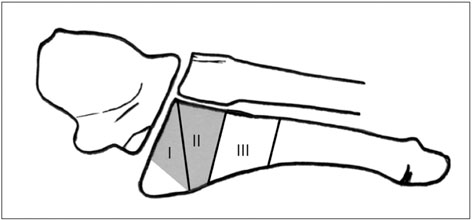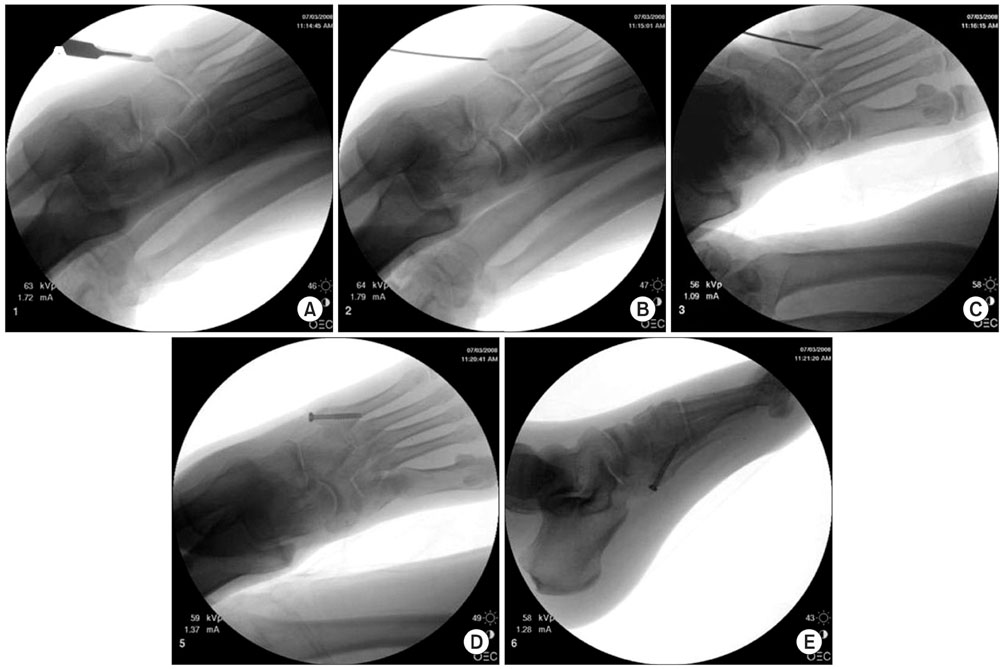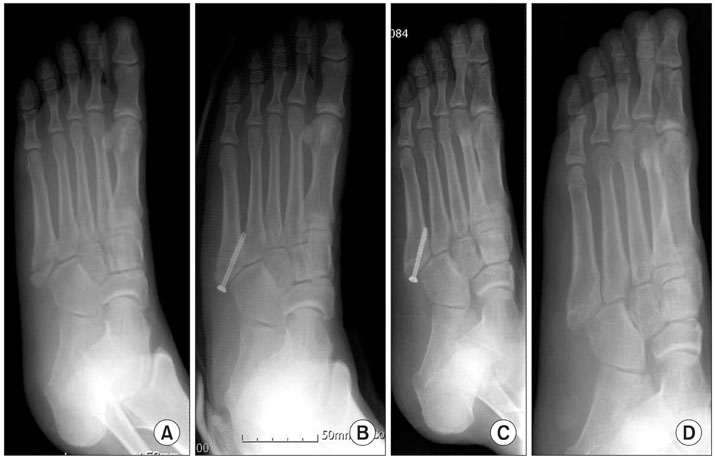Clin Orthop Surg.
2011 Jun;3(2):140-146. 10.4055/cios.2011.3.2.140.
Fractures of the Proximal Fifth Metatarsal: Percutaneous Bicortical Fixation
- Affiliations
-
- 1Department of Orthopedic Surgery, Wenlock Hospital, Kasturba Medical College, Mangalore, India.
- 2Department of Orthopedic Surgery, Haeundae Paik Hospital, Inje University College of Medicine, Busan, Korea.
- 3Department of Orthopedic Surgery, Ilsan Paik Hospital, Inje University College of Medicine, Goyang, Korea. sjs0506@paik.ac.kr
- KMID: 1719311
- DOI: http://doi.org/10.4055/cios.2011.3.2.140
Abstract
- BACKGROUND
Displaced intraarticular zone I and displaced zone II fractures of the proximal fifth metatarsal bone are frequently complicated by delayed nonunion due to a vascular watershed. Many complications have been reported with the commonly used intramedullary screw fixation for these fractures. The optimal surgical procedure for these fractures has not been determined. All these observations led us to evaluate the effectiveness of percutaneous bicortical screw fixation for treating these fractures.
METHODS
Twenty-three fractures were operatively treated by bicortical screw fixation. All the fractures were evaluated both clinically and radiologically for the healing. All the patients were followed at 2 or 3 week intervals till fracture union. The patients were followed for an average of 22.5 months.
RESULTS
Twenty-three fractures healed uneventfully following bicortical fixation, with a mean healing time of 6.3 weeks (range, 4 to 10 weeks). The average American Orthopaedic Foot & Ankle Society (AOFAS) score was 94 (range, 90 to 99). All the patients reported no pain at rest or during athletic activity. We removed the implant in all cases at a mean of 23.2 weeks (range, 18 to 32 weeks). There was no refracture in any of our cases.
CONCLUSIONS
The current study shows the effectiveness of bicortical screw fixation for displaced intraarticular zone I fractures and displaced zone II fractures. We recommend it as one of the useful techniques for fixation of displaced zone I and II fractures.
MeSH Terms
Figure
Cited by 1 articles
-
A Comparison of Bicortical and Intramedullary Screw Fixations in Jones' Fractures Using Finite Element Analysis - Preliminary Report -
Yeon Soo Lee, Jun Young Lee, Sang Soo Park, Chae Won Lim, Eun Ji Kwon
Korean J Sports Med. 2014;32(2):79-84. doi: 10.5763/kjsm.2014.32.2.79.
Reference
-
1. Jones R. I. Fracture of the base of the fifth metatarsal bone by indirect violence. Ann Surg. 1902. 35(6):697–700.2. DeLee JC, Evans JP, Julian J. Stress fracture of the fifth metatarsal. Am J Sports Med. 1983. 11(5):349–353.
Article3. Lawrence SJ, Botte MJ. Jones' fractures and related fractures of the proximal fifth metatarsal. Foot Ankle. 1993. 14(6):358–365.
Article4. Torg JS, Balduini FC, Zelko RR, Pavlov H, Peff TC, Das M. Fractures of the base of the fifth metatarsal distal to the tuberosity: classification and guidelines for non-surgical and surgical management. J Bone Joint Surg Am. 1984. 66(2):209–214.
Article5. Dameron TB Jr. Fractures and anatomical variations of the proximal portion of the fifth metatarsal. J Bone Joint Surg Am. 1975. 57(6):788–792.
Article6. Quill GE Jr. Fractures of the proximal fifth metatarsal. Orthop Clin North Am. 1995. 26(2):353–361.
Article7. Reinherz RP, Sink CA, Westerfield M. Management of trauma to the fifth metatarsal bone. J Foot Surg. 1989. 28(4):301–307.8. Mologne TS, Lundeen JM, Clapper MF, O'Brien TJ. Early screw fixation versus casting in the treatment of acute Jones fractures. Am J Sports Med. 2005. 33(7):970–975.
Article9. Portland G, Kelikian A, Kodros S. Acute surgical management of Jones' fractures. Foot Ankle Int. 2003. 24(11):829–833.
Article10. Rammelt S, Heineck J, Zwipp H. Metatarsal fractures. Injury. 2004. 35:Suppl 2. SB77–SB86.
Article11. Ebraheim NA, Haman SP, Lu J, Padanilam TG, Yeasting RA. Anatomical and radiological considerations of the fifth metatarsal bone. Foot Ankle Int. 2000. 21(3):212–215.
Article12. Shereff MJ, Yang QM, Kummer FJ, Frey CC, Greenidge N. Vascular anatomy of the fifth metatarsal. Foot Ankle. 1991. 11(6):350–353.
Article13. Smith JW, Arnoczky SP, Hersh A. The intraosseous blood supply of the fifth metatarsal: implications for proximal fracture healing. Foot Ankle. 1992. 13(3):143–152.
Article14. Mindrebo N, Shelbourne KD, Van Meter CD, Rettig AC. Outpatient percutaneous screw fixation of the acute Jones fracture. Am J Sports Med. 1993. 21(5):720–723.
Article15. Husain ZS, DeFronzo DJ. Relative stability of tension band versus two-cortex screw fixation for treating fifth metatarsal base avulsion fractures. J Foot Ankle Surg. 2000. 39(2):89–95.
Article16. Husain ZS, DeFronzo DJ. A comparison of bicortical and intramedullary screw fixations of Jones' fractures. J Foot Ankle Surg. 2002. 41(3):146–153.
Article17. Zwitser EW, Breederveld RS. Fractures of the fifth metatarsal: diagnosis and treatment. Injury. 2010. 41(6):555–562.
Article18. Glasgow MT, Naranja RJ Jr, Glasgow SG, Torg JS. Analysis of failed surgical management of fractures of the base of the fifth metatarsal distal to the tuberosity: the Jones fracture. Foot Ankle Int. 1996. 17(8):449–457.
Article19. Kavanaugh JH, Brower TD, Mann RV. The Jones fracture revisited. J Bone Joint Surg Am. 1978. 60(6):776–782.
Article20. Larson CM, Almekinders LC, Taft TN, Garrett WE. Intramedullary screw fixation of Jones fractures: analysis of failure. Am J Sports Med. 2002. 30(1):55–60.21. Wright RW, Fischer DA, Shively RA, Heidt RS Jr, Nuber GW. Refracture of proximal fifth metatarsal (Jones) fracture after intramedullary screw fixation in athletes. Am J Sports Med. 2000. 28(5):732–736.
Article22. Gross TS, Bunch RP. A mechanical model of metatarsal stress fracture during distance running. Am J Sports Med. 1989. 17(5):669–674.
Article23. Kelly IP, Glisson RR, Fink C, Easley ME, Nunley JA. Intramedullary screw fixation of Jones fractures. Foot Ankle Int. 2001. 22(7):585–589.
Article24. Porter DA, Rund AM, Dobslaw R, Duncan M. Comparison of 4.5- and 5.5-mm cannulated stainless steel screws for fifth metatarsal Jones fracture fixation. Foot Ankle Int. 2009. 30(1):27–33.
Article25. Reese K, Litsky A, Kaeding C, Pedroza A, Shah N. Cannulated screw fixation of Jones fractures: a clinical and biomechanical study. Am J Sports Med. 2004. 32(7):1736–1742.26. Vertullo CJ, Glisson RR, Nunley JA. Torsional strains in the proximal fifth metatarsal: implications for Jones and stress fracture management. Foot Ankle Int. 2004. 25(9):650–656.
Article
- Full Text Links
- Actions
-
Cited
- CITED
-
- Close
- Share
- Similar articles
-
- Percutaneous Cannulated Screw Fixation of Fifth Proximal Metatarsal Stress Fracture in Athletes
- A Comparison of Bicortical and Intramedullary Screw Fixations in Jones' Fractures Using Finite Element Analysis: Preliminary Report
- Percutaneous Pinning & External Fixation In the Treatment of Proximal Humerus Fracture
- Fifth Metatarsal Stress Fracture
- Closed Reduction and Percutaneous Fixation in the Treatment of Proximal Humerus Fractures




